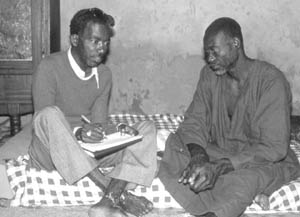
Many factors can contribute towards improving the nutritional situation. Some can be modified through interventions, others not. However, each of these factors must be identified and monitored. The respective roles of the different factors should be considered. Hence the need - as was emphasized previously - for a comprehensive view of the problem based on a broad conceptual causal framework which will guide the choice of indicators.
Once this choice has been made, how are we to collect these indicators on a regular basis, and then ensure that they are used effectively?
As was seen, they may be based on existing indicators or data collected routinely by government services. The first stage is to establish an inter-service consultative group, whether institutionalized or not, through which these indicators or data can be gathered. Care must also be taken to see that data which do not appear in series already established are properly collected via specific surveys; these will be carried out through the services concerned, so as to guarantee a good level of competence while also distributing the work-load fairly.
Then groups responsible for analysis are needed on the various levels, capable of checking the quality of measurements, of establishing the value of the different indicators required, of assembling and comparing indicators from the same level or with the same frequency of collection, of estimating trends, etc.
Finally, interpretation will have to be planned as an inter-sectoral task. This will allow, for example, (i) comparing the value of indicators to previous estimates and to the objectives set, and (ii) making appropriate decisions: to continue or modify current interventions, to decide new interventions, to re-examine certain problems through new, more specific, data collection, and to disseminate the information to various users, etc.
In practice, analysis and interpretation must be planned at each collection level, so that the information is prepared for the next level up, while also highlighting information needed for its own purposes. Thus, regional managers of a programme must be able to extract their own information from the indicators collected as part of the programme, then make the indicators available to national decision-makers or planners if necessary; national decision-makers will in turn provide programme managers with national indicators where needed.
The main problem is that of collecting all the necessary information but only the necessary information. Collection can be expensive, and there is no point in using often limited resources to collect irrelevant or unnecessary data. The ability to limit the choice to the most useful indicators is a guarantee of the efficiency and sustainability of monitoring systems. However, non-collection can also be expensive, for the lack of a necessary indicator when conducting an assessment can lead to wrong decisions regarding the programme, which will obviously have a cost. In the case of uncertainty over whether or not to collect data because of cost, the latter must be weighed against the consequences of non-collection and the total cost of the programme. However, the answer will very often be provided by the prior, and then ongoing, conceptual reflection, which is in all respects an indispensable process for the choice of indicators for monitoring situations.
|
Selection of indicators: the steps to follow*
1. Develop a conceptual framework of the nutritional situation comprising an analysis at the different levels - national, regional and community; * These steps may initially be followed in sequence; subsequently, an iterative mode will be established, to refine the process or due to changes in the situation considered. |